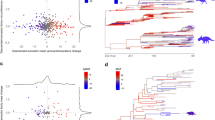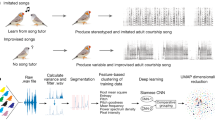Abstract
Locomotion in living birds (Neornithes) has two remarkable features: feather-assisted flight, and the use of unusually crouched hindlimbs for bipedal support and movement. When and how these defining functional traits evolved remains controversial1,2,3,4,5,6,7,8. However, the advent of computer modelling approaches and the discoveries of exceptionally preserved key specimens now make it possible to use quantitative data on whole-body morphology to address the biomechanics underlying this issue. Here we use digital body reconstructions to quantify evolutionary trends in locomotor biomechanics (whole-body proportions and centre-of-mass position) across the clade Archosauria. We use three-dimensional digital reconstruction to estimate body shape from skeletal dimensions for 17 archosaurs along the ancestral bird line, including the exceptionally preserved, feathered taxa Microraptor, Archaeopteryx, Pengornis and Yixianornis, which represent key stages in the evolution of the avian body plan. Rather than a discrete transition from more-upright postures in the basal-most birds (Avialae) and their immediate outgroup deinonychosauria5,6, our results support hypotheses of a gradual, stepwise acquisition of more-crouched limb postures across much of theropod evolution1,2,3,4, although we find evidence of an accelerated change within the clade Maniraptora (birds and their closest relatives, such as deinonychosaurs). In addition, whereas reduction of the tail is widely accepted to be the primary morphological factor correlated with centre-of-mass position and, hence, evolution of hindlimb posture1,2,3,4,5,6,7,8, we instead find that enlargement of the pectoral limb and several associated trends have a much stronger influence. Intriguingly, our support for the onset of accelerated morpho-functional trends within Maniraptora is closely correlated with the evolution of flight. Because we find that the evolution of enlarged forelimbs is strongly linked, via whole-body centre of mass, to hindlimb function during terrestrial locomotion, we suggest that the evolution of avian flight is linked to anatomical novelties in the pelvic limb as well as the pectoral.
This is a preview of subscription content, access via your institution
Access options
Subscribe to this journal
Receive 51 print issues and online access
$199.00 per year
only $3.90 per issue
Buy this article
- Purchase on Springer Link
- Instant access to full article PDF
Prices may be subject to local taxes which are calculated during checkout





Similar content being viewed by others
References
Gatesy, S. M. Caudofemoral musculature and the evolution of theropod locomotion. Paleobiology 16, 170–186 (1990)
Gatesy, S. M. in Functional Morphology in Vertebrate Paleontology (ed. Thomason, J. J.) Ch. 13 (Cambridge Univ. Press, 1995)
Hutchinson, J. R. & Gatesy, S. M. Adductors, abductors, and the evolution of archosaur locomotion. Paleobiology 26, 734–751 (2000)
Hutchinson, J. R. & Allen, V. The evolutionary continuum of limb function from early theropods to birds. Naturwissenschaften 96, 423–448 (2009)
Gatesy, S. M. Hind limb scaling in birds and other theropods: implications for terrestrial locomotion. J. Morphol. 209, 83–96 (1991)
Christiansen, P. & Bonde, N. Limb proportions and avian terrestrial locomotion. Geology 371, 356–371 (2002)
Gatesy, S. M. & Dial, K. P. Locomotor modules and the evolution of avian flight. Evolution 50, 331–340 (1996)
Jones, T. D., Farlow, J. O., Ruben, J. A., Henderson, D. M. & Hillenius, W. J. Cursoriality in bipedal archosaurs. Nature 406, 716–718 (2000)
Herr, H. & Popovic, M. Angular momentum in human walking. J. Exp. Biol. 211, 467–481 (2008)
Roberts, T. J. & Scales, J. A. Mechanical power output during running accelerations in wild turkeys. J. Exp. Biol. 205, 1485–1494 (2002)
Clark, J. & Alexander, R. M. Mechanics of running by quail (Coturnix). J. Zool. 176, 87–113 (1975)
Hancock, J. A., Stevens, N. J. & Biknevicius, A. R. Whole-body mechanics and kinematics of terrestrial locomotion in the Elegant-crested Tinamou Eudromia elegans. Ibis 149, 605–614 (2007)
Roberts, T. J., Chen, M. S. & Taylor, C. R. Energetics of bipedal running II: limb design and running mechanics. J. Exp. Biol. 2762, 2753–2762 (1998)
Carrano, M. T. & Biewener, A. A. Experimental alteration of limb posture in the chicken (Gallus gallus) and its bearing on the use of birds as analogues for dinosaur locomotion. J. Morphol. 240, 237–249 (1999)
Biewener, A. A., Farley, C. T., Roberts, T. J. & Temaner, M. Muscle mechanical advantage of human walking and running: implications for energy cost. J. Appl. Physiol. 97, 2266–2274 (2004)
Hutchinson, J. R. Biomechanical modeling and sensitivity analysis of bipedal running ability. I. Extant taxa. J. Morphol. 262, 421–440 (2004)
Tarsitano, S. Stance and gait in theropod dinosaurs. Acta Palaeontol. Pol. 28, 251–264 (1983)
Allen, V., Paxton, H. & Hutchinson, J. R. Variation in center of mass estimates for extant sauropsids and its importance for reconstructing inertial properties of extinct archosaurs. Anat. Rec. 292, 1442–1461 (2009)
Gatesy, S. M. & Middleton, K. M. Bipedalism, flight, and the evolution of theropod locomotor diversity. J. Vertebr. Paleontol. 17, 308–329 (1997)
Farlow, J. O., Gatesy, S. M., Holtz, T. R. J., Hutchinson, J. R. & Robinson, J. M. Theropod locomotion. Am. Zool. 40, 640–663 (2000)
Persons, W. S. & Currie, P. J. The tail of Tyrannosaurus: reassessing the size and locomotive importance of the M. caudofemoralis in non-avian theropods. Anat. Rec. 294, 119–131 (2011)
Hutchinson, J. R., Bates, K. T., Molnar, J., Allen, V. & Makovicky, P. J. A Computational analysis of limb and body dimensions in Tyrannosaurus rex with implications for locomotion, ontogeny, and growth. PLoS ONE 6, e26037 (2011)
Gatesy, S. M. An electromyographic analysis of hindlimb function in Alligator during terrestrial locomotion. J. Morphol. 234, 197–212 (1997)
Gatesy, S. M. Guineafowl hind limb function. II: electromyographic analysis and motor pattern evolution. J. Morphol. 240, 127–142 (1999)
Marsh, R. L., Ellerby, D. J., Henry, H. T. & Rubenson, J. The energetic costs of trunk and distal-limb loading during walking and running in guinea fowl Numida meleagris I. Organismal metabolism and biomechanics. J. Exp. Biol. 209, 2050–2063 (2006)
Turner, A. H., Makovicky, P. J. & Norell, M. A. Feather quill knobs in the dinosaur Velociraptor. Science 317, 1721 (2007)
Hutchinson, J. R. The evolution of hindlimb tendons and muscles on the line to crown-group birds. Comp. Biochem. Physiol. A 131, 169–197 (2001)
Hutchinson, J. R., Ng-Thow-Hing, V. & Anderson, F. C. A 3D interactive method for estimating body segmental parameters in animals: application to the turning and running performance of Tyrannosaurus rex. J. Theor. Biol. 246, 660–680 (2007)
Chatterjee, S. & Templin, R. J. Biplane wing planform and flight performance of the feathered dinosaur Microraptor gui. Proc. Natl Acad. Sci. USA 104, 1576–1580 (2007)
Bates, K. T., Manning, P. L., Hodgetts, D. & Sellers, W. I. Estimating mass properties of dinosaurs using laser imaging and 3D computer modelling. PLoS ONE 4, e4532 (2009)
Acknowledgements
We thank the following people and institutions for access to fossil specimens: S. Chapman, A. Milner, P. Holroyd, M. Goodwin, K. Padian, M. Ryan, G. Jackson, D. Chapman, H.-J. Siber, B. Pabst, Z. Zhou and M. Norell; and the NHM (UK), UCMP (USA), CMNH (USA), IVPP (Canada); Sauriermuseum Aathal (Switzerland) and AMNH (USA). We wish to thank the following people, institutions and companies for providing digitized specimens, reconstructed specimens or both: O. Grillo, H. Mallison, J. Hertel, J. Brougham, M. Davis, J. A. Bannister; and the Universidade Federal do Rio de Janeiro (Brazil), MNB (Germany), Crescendo Games (Canada), NOVA/WGBH (USA) and Mechanimal (USA). We thank J. Molnar and RVC for invaluable assistance in processing computed tomography and laser-scan data, and for video editing. This work was supported by the following grants and institutions: NERC grant no. NE/G005877/1 to J.R.H., a Royal Society International Joint Project to J.R.H. and Z. Zhou (not a co-author), and the Sam and Doris Welles Fund (University of California) as part of PhD funding to V.A.
Author information
Authors and Affiliations
Contributions
K.T.B., V.A. and Z.L. digitized fossil material. V.A. and K.T.B. constructed and analysed volumetric reconstructions. J.R.H. and V.A. performed phylogenetic optimization analysis. V.A. performed all statistical analyses. J.R.H. supervised and contributed ideas throughout the project. All authors contributed to the manuscript.
Corresponding author
Ethics declarations
Competing interests
The authors declare no competing financial interests.
Supplementary information
Supplementary Information
This file contains Supplementary Text on text on evolutionary trends in morphological evolution, investigation of scaling and phylogenetic biases as well as alternate phylogenetic relationships, Supplementary References, Supplementary Figures 1-3 (including dorsoventral CoM changes and alternative phylogeny with analyses complementing Figures 1,3-5) and Supplementary Tables 1-12 that provide specimen information and data for all major inputs and outputs of our analyses. (PDF 956 kb)
Visualization of 3D modelling approach for extinct animal body dimensions
Reconstruction (flesh and air spaces) and iteration (minimum, maximum masses) methodology, using Allosaurus as an example. (MOV 12274 kb)
Rotating videos of all 17 archosaurs modelled and their relations to the main stem of archosaur phylogeny.
All 17 archosaurian models shown by proceeding in sequence along the phylogeny in Figure 1, showing specimens (with specimen numbers in brackets; see Supplementary Table S1) that are connected to nodes 1-16 as a means of visually conveying gross changes in body proportions along the bird-line. Note that the precise morphology of individual specimens is not ancestral at the nodes but is correlated with that ancestral morphology; see Figures 3-5 and Supplementary Information for details on ancestral morphology. (MOV 29309 kb)
Rights and permissions
About this article
Cite this article
Allen, V., Bates, K., Li, Z. et al. Linking the evolution of body shape and locomotor biomechanics in bird-line archosaurs. Nature 497, 104–107 (2013). https://doi.org/10.1038/nature12059
Received:
Accepted:
Published:
Issue Date:
DOI: https://doi.org/10.1038/nature12059
This article is cited by
-
Decoupling body shape and mass distribution in birds and their dinosaurian ancestors
Nature Communications (2023)
-
Three-dimensional polygonal muscle modelling and line of action estimation in living and extinct taxa
Scientific Reports (2022)
-
Body size, shape and ecology in tetrapods
Nature Communications (2022)
-
The relationship between sternum variation and mode of locomotion in birds
BMC Biology (2021)
-
Fast-running theropods tracks from the Early Cretaceous of La Rioja, Spain
Scientific Reports (2021)
Comments
By submitting a comment you agree to abide by our Terms and Community Guidelines. If you find something abusive or that does not comply with our terms or guidelines please flag it as inappropriate.



